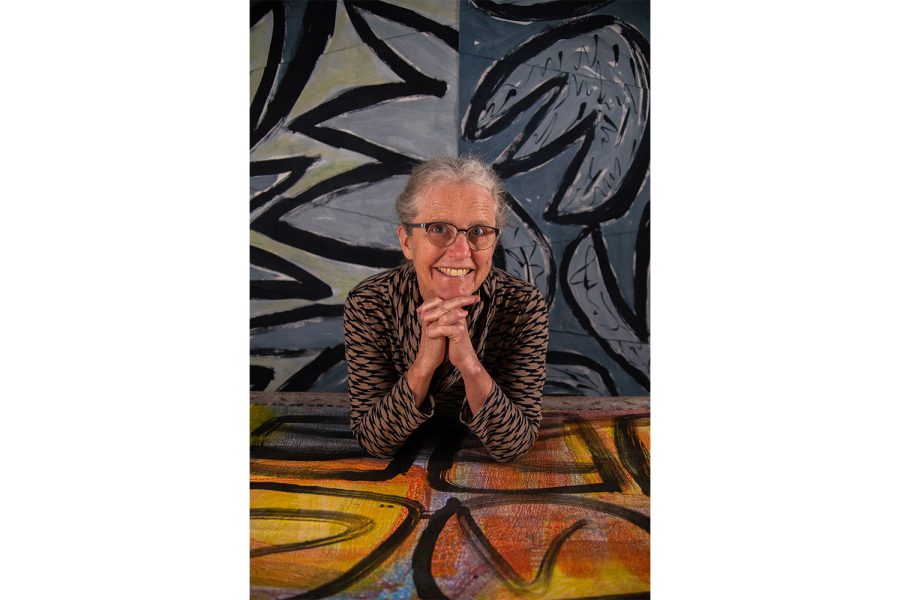Public Space One hosts ‘INDIGO!’ art exhibition reception
Iowan textile artist Astrid Bennett hosted the opening reception for ‘INDIGO!’ — a collection of Indigo-dye art made by her and her peers — on Aug. 19. The exhibition, hosted at Public Space One, aims to focus on the beauty and craftsmanship of Indigo art, and to educate people about its artistic process and history as an art form.
August 22, 2022
Astrid Bennett, an Iowa City-based textile artist, curated the “INDIGO!” art exhibition, which opened on Aug. 19 at Public Space One’s North gallery. The exhibit will be open to view until Sept. 9.
Indigo dye is extracted from Indigo plants. With proper maintenance, it can be stored in a vat for years before it is used as a vivid, striking dye.
When people were confined to their homes during the COVID-19 pandemic, Bennett discovered a way to express her creativity and socialize with her friends through Indigo dyeing. Aside from Bennett’s own work, the exhibit also included pieces created by Bennett’s friends, other professional artists, and a few MFA students at the University of Iowa.
The intricate patterns, range of materials used, and the pieces themselves were intensely eye-catching. Not only cloth, but also paper, ceramics, and even chopsticks were used to put together the articles dyed with a bright Indigo, and occasionally other dyes.
RELATED: Davenport museum adds UI alum’s work to permanent collection
Bennett held up a shawl in her hands as she described how it was possible to create as complex a design as the one depicted.
“Unlike the vast majority of dyes, Indigo stops when there is the slightest resistance,” Bennett said. “When we were making these, people folded, twisted, stitched, tied up cloth, paper, and even yarn. When it is in the vat, the dye is green. It oxidizes to turn blue.”
Sometimes the cloth is intentionally “overdyed” to vary the blues with deep sea green, brown, and pale pink, Bennett noted. Her expertise as an artist was evident in the highly detailed pieces showcased at the exhibit. Bennett earned her bachelor’s degree in textile art from Indiana University.
“I’ve been a textile fiber artist since college,” she said. “I also work right now as the President of the international textile nonprofit, ‘Surface Design Association.’”
Bennett’s Indigo-dyed pieces, unlike the others, were imprinted with sketches. She explained that after dying the fabric for each piece, she paints them with India ink, “combining her love” of drawing and painting.
Bennett also noted that, while sometimes the figures she depicts are plants, her work is usually very abstract.
“I am inspired by the natural world. I am a gardener,” Bennett said. “But I am also a musician, which is why I like to do abstract work. It shows the rhythm of drawing and painting.”
Jan Friedman, a professional weaver for 46 years and an MFA graduate in weaving from the University of Iowa, attended the exhibition. Her own piece in the display experimented with pulling stitches together and apart to make the Indigo dye spread into designs.
“I like the way Astrid incorporated the Japanese Noren,” Friedman said, referencing the Indigo-dyed tapestries hanging in the entranceway of the exhibition.
“I’ve done Indigo with Astrid for years, but some effects — you really don’t know how it is done,” said Leslie Bruch, a friend of Bennett and fellow artistic contributor. “Some effects you have no idea how they are gonna turn out.”
Toward the end of the event, Bennett reminded her audience not to limit their experience by only taking in the visual aspect of the pieces.
“Indigo has a bad colonial past. Enslaved people were brought to raise it because they were so good at it. We want to honor all sides of it here,” Bennett said. “Our goal is not just to show the magic of Indigo, but also how it is entwined with all these other issues.”
Bennett said she intends to donate 20 percent of her earnings from this sale to Public Space One to express her gratitude to the organization for accommodating the exhibit.



